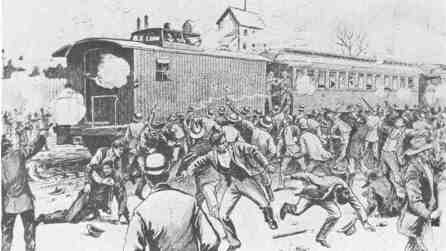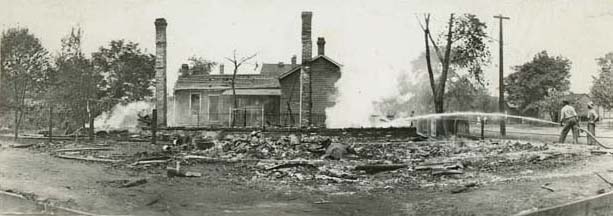Teaching Activity. By Gayle Olson-Raymer. 17 pages.
Questions and teaching ideas for Chapter 13 of Voices of a People's History of the United States on the labor movement at the turn of the century.
Continue reading
Book — Fiction. By Marie Raphael. 2007. 217 pages.
Historical fiction about the life of the Irish in New York City at the beginning of the 20th century for ages 12+.
Continue reading
Teaching Activity. By Mike Benbow and Robin Pickering. 17 pages.
Questions and teaching ideas for Chapter 18 of Voices of a People's History of the United States on opposition to the Vietnam War.
Continue reading
Teaching Activity. By Wayne Wah Kwai Au. Rethinking Schools. 5 pages.
Lesson on the history of Hawai'i and the impact of colonization and tourism.
Continue reading
Book — Non-fiction (with CD). Edited by William H. Chafe, Raymond Gavins and Robert Korstad. 2008. 346 pages.
Extensive oral history of African American life under segregation.
Continue reading
Book — Fiction. By Margarita Engle. 2016. 272 pages.
Historical fiction in free verse about the building of the Panama Canal.
Continue reading
Teaching Activity. By John DeRose. Rethinking Schools. 4 pages.
Analysis of textbook passages from different countries, videos and books are used to explore different perspectives about the same event in history, i.e. "Philippine-American War" vs. "War of Philippine Independence."
Continue reading
Teaching Activity. By Bill Bigelow. 7 pages.
Students read a poignant excerpt from Agnes Smedley's novel, Daughter of Earth, and use it to think and write about how schooling—their own included—teaches lessons about social class.
Continue reading
Audio. By Howard Zinn. Read by Matt Damon. 2003. 8 hours, 44 minutes.
Audio book version of excerpted highlights from A People's History of the United States.
Continue reading
Book — Non-fiction. By Howard Zinn. 2005, with a new introduction by Anthony Arnove in 2015. 784 pages.
Howard Zinn's groundbreaking work on U.S. history. This book details lives and facts rarely included in textbooks—an indispensable teacher and student resource.
Continue reading
Book — Fiction. By Victoria Bond and T. R. Simon. 2010. 186 pages.
A coming-of-age story inspired by the early life of Zora Neale Hurston for ages 10 and up.
Continue reading
Film. By Kristy Andersen. 2008. 84 minutes.
Documentary about the life, literature, and research of Zora Neale Hurston.
Continue reading
Teaching Activity. By Teaching Tolerance.
Introduces students to the role of the labor movement in securing contemporary benefits such as the 40-hour work week, the minimum wage, and workplace safety regulations.
Continue reading
Book — Non-fiction. By Blair L. M. Kelley. 2010. 280 pages.
Examines acts of protest and resistance to segregated trains and streetcars during the early Jim Crow era.
Continue reading
Book — Fiction. By John Sayles. 2011. 955 pages.
Spanning five years and half a dozen countries, Sayles' novel of historical fiction paints a picture of the late 1890s — from the racist coup in Wilmington, North Carolina, to the bloody dawn of U.S. interventionism in Cuba and the Philippines.
Continue reading
Teaching Activity. By Bill Bigelow and Bob Peterson. Rethinking Schools. 4 pages.
Using photographs to spark creative writing and critical thinking about child labor issues and social justice.
Continue reading
Profile.
Mother Jones (1830–1930) was a labor leader and organizer.
Continue reading
Book — Non-fiction. By Keith Medley. 2012. 256 pages.
This book documents the untold history of the organizing leading up the Plessy v. Ferguson case.
Continue reading
Book — Fiction. By Margarita Engle. 2012. 144 pages.
A portrait in verse of a young girl struggling with dyslexia in Cuba at the turn of the 20th century.
Continue reading
The Ex-Slave Mutual Relief, Bounty, and Pension Association was founded with a dual mission to organize mutual aid for its members and to pass federal pension legislation that would compensate every formerly enslaved person.
Continue reading
Local 25 of the International Ladies’ Garment Workers’ Union (ILGWU) declared a strike.
Continue reading
This massacre was committed against African Americans by a mob of about 5,000 white people in Springfield, Illinois.
Continue reading
President William Howard Taft ordered U.S. warships to Nicaragua to defend U.S. corporate profits.
Continue reading
The Mississippi Constitution was one of the first pieces of legislation that provided a uniform system of free public education for children regardless of race.
Continue reading
An unexpected hurricane crashed into the Gulf Coast and devastated Galveston, Texas, leaving thousands of people dead and even more left houseless. The storm’s turmoil and destruction allowed white terror and fraud to flourish.
Continue reading

























